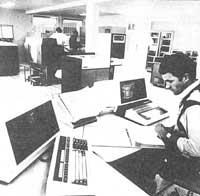Lympias died long ago
1988/10/01 Oilarra, A. Iturria: Elhuyar aldizkaria
Orlando Elorrieta and Xabier Erauskin pointed out in class that the first phase of this process is the collection of information through teletype and telefax. If information is obtained, the editors write the news on the screen that each one has. Each editor has its code so that the information written on this screen is protected. What happens is that to remember this code, journalists use some special things.
Following the process, the following was explained: Each newspaper delegation has a computer connected to the center. In writing (when writing) they use a word processor taking advantage of their advantages.

It is written as in a typewriter and then, using the control characters, the font and body are selected (that is, the size), although when writing everything is done the same, when all the articles are inserted in the computers, all are sent to a central machine as they should appear and placing the rest of orders. Therefore, this machine writes the texts as they appear in the newspaper, the same texts written with the same letter.
The biggest change they have noticed lately in this process is the one related to assembly. Before, and in some cases also now, the articles were written on photographic paper (with the approximate width of a column) and the assemblers cut and glued them on a newspaper page.
But today the whole page comes out. For the writing of an article, newspaper officials decide how each text will be taken out.
The use of the computer has its advantages. The length of the articles is controlled. While the previous models had to see reds, today computers do. For example, if the article is too short, leave more space between the lines for everything to be matched.
Or if it's too long, it says it doesn't come in and then you have to cut it. To finish the process, a photo is taken from this page and the negative (aluminum plate) is taken to the press to remove the newspaper. This is the process of the newspaper.
Therefore, it is clear that the newspaper's firing process has been greatly streamlined, as most things are done through computers. This relief has occurred especially in the field of layout.

Gai honi buruzko eduki gehiago
Elhuyarrek garatutako teknologia




